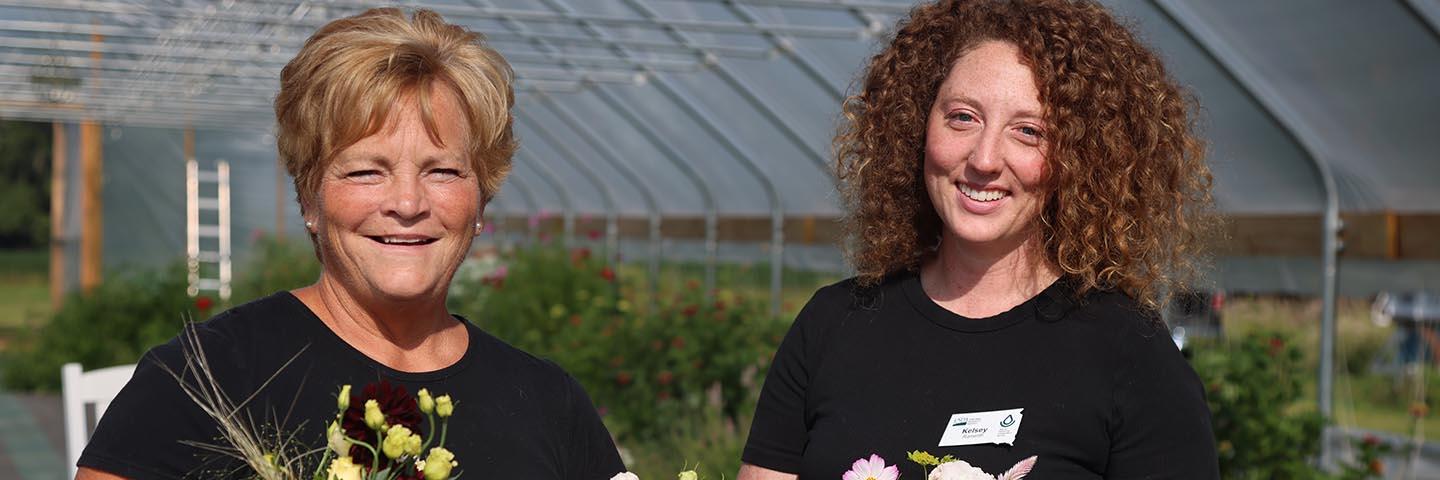Growing to New Heights with NRCS

Rhonda Larson (L) worked with NRCS District Conservationist Kelsey Ramerth (R) to sign up with EQIP to address the water and soil resource concerns with her flower business.
NATURAL RESOURCES CONSERVATION SERVICE, Huron, S.D., Oct. 30, 2023 – During the school year Rhonda Larson serves special needs students as a teaching aide in Hamlin County, South Dakota. When she is not focused on her day job, her passion is flowers, a tradition that was passed down from her mother and grandmother. That passion has sprouted into a blooming cut flower business.
Rhonda began by growing many of her flowers in her basement and a makeshift shed on her family’s farmstead in Hayti, South Dakota. She began selling her flowers at farmers markets and continued growing her business from there. As her business began to flourish, Rhonda wanted to expand beyond the confines of her shed and basement. With the blessing of her husband, Rhonda added part of an old soybean field to expand her operation and increase her yields. Because her husband is a farmer, she was already familiar with the Natural Resources Conservation Service (NRCS) and reached out to learn how NRCS could help her reach her goals.
To lengthen her growing season, Rhonda opted for a high tunnel using financial assistance through the Environmental Quality Incentive Program’s (EQIP) High Tunnel Initiative. Given the nature of the old soybean field, Rhonda had immediate concerns about the soil and how to deliver much needed water to the plants. Working with District Conservationist Kelsey Ramerth, a conservation plan was developed to ensure that the high tunnel was in an advantageous location and to address the water and soil resource concerns.
“I could not have done this without Kelsey,” Rhonda said. “She gave me the confidence to take this leap and the information to make it work.”
Rhonda and her daughter completed construction of the high tunnel in November 2022 and immediately began working on tackling the other resource concerns. Through EQIP, Rhonda added a micro irrigation system to help provide water to the tunnel and implemented mulching to help deal with soil health resource concerns. She also added a Conservation Reserve Program pollinator planting between the new high tunnel and the adjacent soybean field to create more pollinator habitat, a critical component for a cut flower business.
Despite the goals that she has achieved, this is not a stopping point for Rhonda. Now that her flower garden stands at just under an acre with the high tunnel, it serves as a launching point for her future endeavors.
“Before the high tunnel I didn’t have the confidence to call this a business,” Rhonda said.
With her high tunnel and other conservation practices established, Rhonda has continued to set goals for the future.
“I want to continue to diversify my flower offerings, add more vegetables to my operation, and maybe sell seedlings,” she said.
Rhonda has taken the love of flowers passed down from her mother and ran with it, bringing her budding operation to new heights. She is dedicated to creating an operation that will last and wishes to share her love of flowers with the greater community. She wants to not only increase her participation with farmer’s markets across the state, but also invite students from her school and others to tour her operation so she can share her passion with them as well.
“This is where I am happiest,” she said.
The NRCS has many voluntary programs designed to assist producers with implementing conservation. EQIP offers technical and financial assistance for producers interested in getting conservation on the ground. The Conservation Stewardship Program, or CSP, assists producers by compensating them for implementing conservation on their operations.
For fiscal year (FY) 2024, NRCS is investing more into climate-smart mitigation activities. Through the Inflation Reduction Act, USDA programs have expanded access for producers no matter the size or shape of the operation. The application date for FY 2024 funding is November 3, 2023, so reach out to your local USDA Service Center today to learn more and apply.
#

